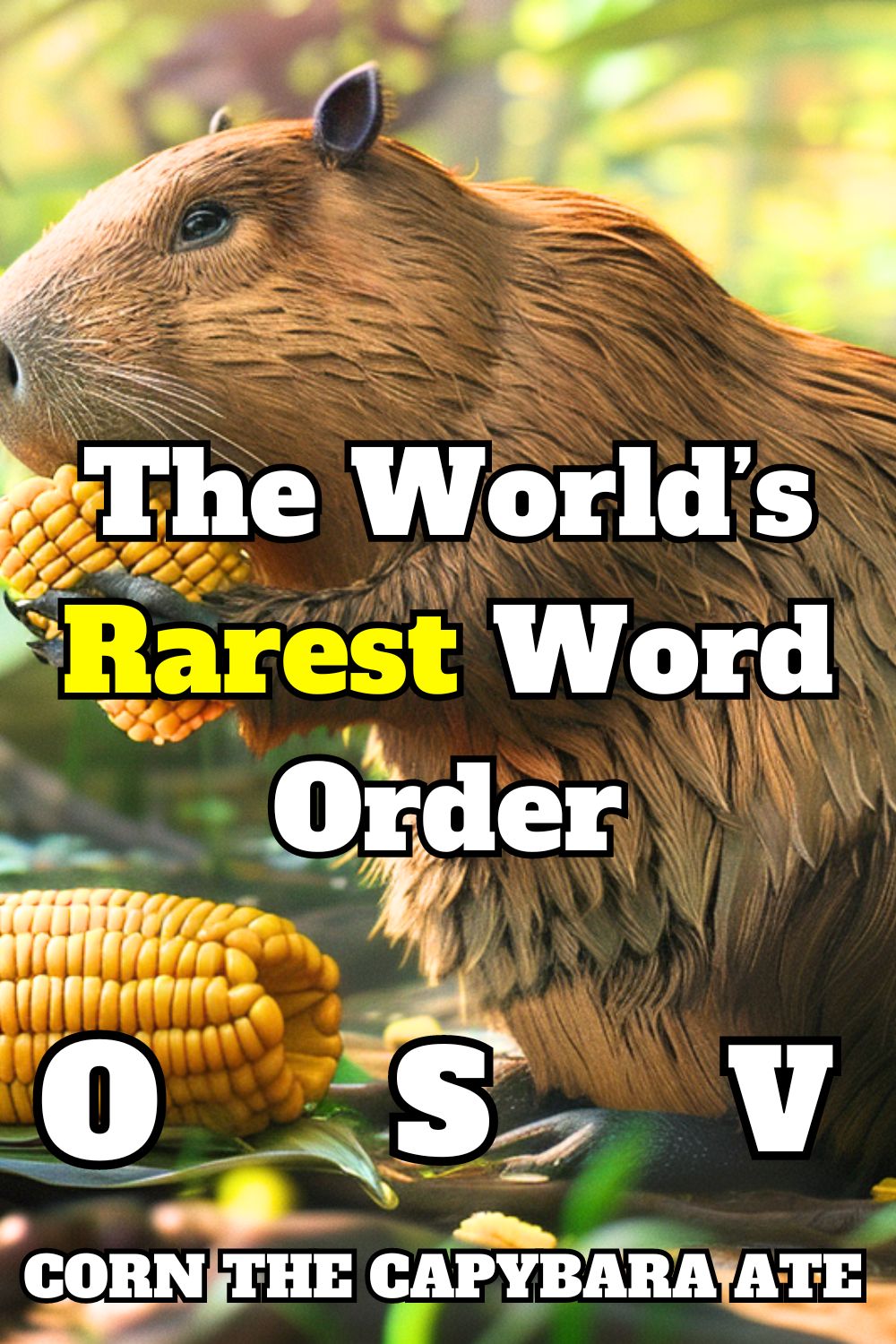Language is a mesmerizing puzzle, constantly evolving and varying across the globe. When we think about sentence structure, most of us default to the familiar “Subject-Verb-Object” (SVO) order, like in English. But did you know there’s a super rare word order pattern that flips this entirely on its head? Welcome to the world of “Object-Subject-Verb” (OSV), the rarest of all linguistic arrangements.
In the video “OSV: Why is this word order so rare in languages?” NativLang explores the intriguing topic of OSV word order, exploring why it is so uncommon and where it can be found.
This article will provide an engaging summary of the insights presented in the video, uncovering OSV’s mysteries and celebrating linguistic structure diversity.
The Rare Gems of Global Sentence Structures
Imagine being in a classroom, tasked with creating a simple sentence: “The capybara ate corn.” Most English speakers would instinctively follow the SVO pattern. However, if you traveled around the world, you’d encounter a fascinating array of sentence structures. In many Indian languages, you might find the “Subject-Object-Verb” (SOV) order, while in Madagascar, “Verb-Object-Subject” (VOS) is the norm.
Yet, among these configurations, one stands out for its sheer rarity: OSV. This peculiar structure, where the object comes first, followed by the subject and verb, is like a rare gem in the vast linguistic landscape. It’s predominantly found in the Amazon, spoken by languages like Apurinã and Warao.
The Quest for Understanding
The journey into the mysteries of word order often begins with a fascination for languages. As a teenager, one might delve into various languages, each time encountering three defining letters: S, V, and O. These symbols become more than grammatical markers; they transform into a sort of linguistic horoscope, guiding the understanding of language types.
Fast forward a decade, and the quest for knowledge resumes, discovering that while some word orders are commonplace, others are incredibly scarce. This curiosity further explores into why certain word orders, like OSV, are so uncommon.
The Six Word Orders
To appreciate the diversity of word orders, let’s explore the six possible configurations with sample sentences:
1. Subject-Object-Verb (SOV):
Example: “The capybara corn ate.”
Languages: Japanese, Hindi
2. Subject-Verb-Object (SVO):
Example: “The capybara ate corn.”
Languages: English, German, Chinese
3. Verb-Subject-Object (VSO):
Example: “Ate the capybara corn.”
Languages: Arabic, Irish
4. Verb-Object-Subject (VOS):
Example: “Ate corn the capybara.”
Languages: Malagasy, Fijian
5. Object-Verb-Subject (OVS):
Example: “Corn ate the capybara.”
Languages: Hixkaryana, a Carib language
6. Object-Subject-Verb (OSV):
Example: “Corn the capybara ate.”
Languages: Apurinã, Warao
Why OSV is So Rare
Linguists have long pondered the rarity of OSV. It turns out that most languages tend to keep the subject at the forefront, making SOV and SVO the most common orders. This preference aligns with how we process information: we like to know who is doing what to whom right away.
However, OSV flips this logic, placing the object—the recipient of the action—first. This unconventional structure defies typical linguistic patterns, creating a unique challenge for language learners. Some theories suggest that our brains might have a natural inclination against OSV, making it harder for such languages to flourish.
The Flexibility Factor
Despite its rarity, OSV has found a home in the Amazon. But even here, languages exhibit remarkable flexibility.
For instance, in Warao, storytellers switch from OSV to SOV when introducing new characters, demonstrating that context plays a crucial role in word order.
This flexibility isn’t unique to Amazonian languages. In Korean and Mayan languages, OSV sentences appear alongside more common orders, illustrating that word order is often more fluid than fixed.
Reflecting on the Rare Charm of OSV
The story of OSV is a celebration of linguistic diversity. It reminds us that languages are not static but dynamic and influenced by countless factors, including cultural interactions, colonization, and internal evolution. Each language, with its unique structure, offers a window into the human mind and our shared history.
So, the next time you marvel at the intricacies of language, remember the rare and fascinating OSV order. It’s a testament to the rich diversity of human expression, reminding us that even the rarest linguistic phenomena have a place in our world. And perhaps, in the vast expanse of the Amazon, there’s a storyteller weaving a tale in OSV, keeping this rare word order alive and thriving.
For those inspired to learn more, supporting preserving these unique languages is vital. They are not just words but the voices of cultures and histories that enrich our global heritage. And who knows? Maybe one day, you’ll find yourself speaking a language with the rare OSV order, contributing to its legacy.

Hey fellow Linguaholics! It’s me, Marcel. I am the proud owner of linguaholic.com. Languages have always been my passion and I have studied Linguistics, Computational Linguistics and Sinology at the University of Zurich. It is my utmost pleasure to share with all of you guys what I know about languages and linguistics in general.


